Posts
How to find a new development opportunity

Decided to take on a property development opportunity? We don’t blame you! There’s something incredibly rewarding about seeing a property come together through your own planning, dedication and hard work.
However, at the beginning, such a project can seem a little intimidating and daunting and it’s difficult to figure out where to start. So how do you go about developing an existing property- or building on from scratch?
Here are some ideas on how to find that perfect project so that you can get to work!
1. Make contact with the local commercial agents
A quick Google search will point you in the right direction.
2. Research old and redundant buildings
Look at examples of others who have undertaken this type of work to draw inspiration. Then do some research into old and redundant buildings- do any have potential?
3. Auctions for land
Land auctions are a good way to find suitable plots but transactions are conducted on a ‘sold as seen’ basis and therefore require a quick sale, leaving little time for research:
cooperandtanner.co.uk/Proeprty-and-land-Auctions
countrywidepropertyauctions.co.uk
4. Local authorities
Cash-strapped councils often have parcels of land they are willing to sell.
5. Utility companies
Some utility organisations such as water, gas and electricity companies have surplus land available to buy:
dailymail.co.uk/news/article-12290/BT-raise-2bn-property-sell-off.html
6. Previously approved schemes which have not been built
7. Change of use on office to residential
The objective is to allow changes of use of a building or land from B1(a): offices to C3: residential to happen more easily. The intended effect of the proposal is to support an increase in housing supply, encourage regeneration of offices and bring empty properties into productive use.
8. Barn conversion under permitted development
Agricultural buildings can be converted to a flexible, educational or residential use under permitted development rights:

Basic principles for extending listed buildings

Clients often come to us asking how they might achieve an extension or alteration to a listed building.
This can be tricky project to take on because any works of alteration, extension of demolition to a listed building requires listed building consent. This often also applies to repairs, so it is always wise to get advice from the local authority before carrying out any work.
Most historic buildings reflect the cumulative changes of different owners and uses, however in the past these changes and additions may have been made without the constraints of planning authorities.
Alterations to a listed building can be made as long as they do not damage the significance of the building and its setting. Given the variety of historic building types and their individual characteristics, what might work on one site won’t necessarily work on another.
Some listed buildings are much more sensitive to change than others, so each case for change needs to be assessed individually to ensure success.
Basic principles for extending listed buildings
- The design and construction of the extension should show an understanding of the heritage significance of the listed building and it’s setting.
- The design should seek to minimise any harm to the listed building’s heritage value or special interest.
- The extension should normally play a subordinate role and not dominate the listed building as a result of its scale, mass, siting or materials.
- The new addition should sustain and add value to the listed building’s significance by being of high quality design, craftsmanship and materials.



